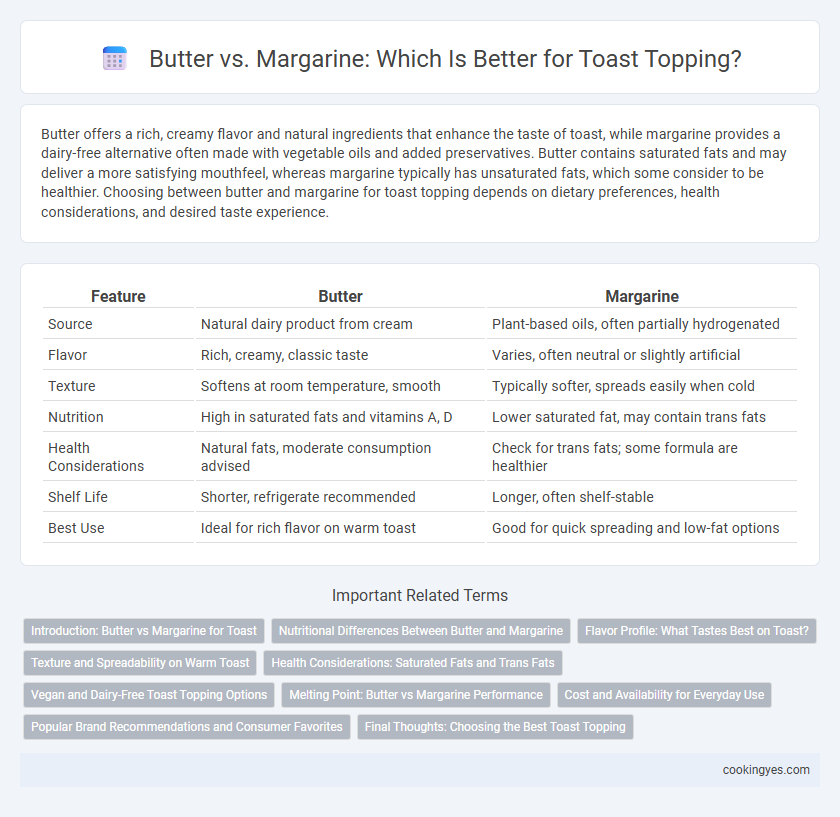Butter offers a rich, creamy flavor and natural ingredients that enhance the taste of toast, while margarine provides a dairy-free alternative often made with vegetable oils and added preservatives. Butter contains saturated fats and may deliver a more satisfying mouthfeel, whereas margarine typically has unsaturated fats, which some consider to be healthier. Choosing between butter and margarine for toast topping depends on dietary preferences, health considerations, and desired taste experience.
Table of Comparison
| Feature | Butter | Margarine |
|---|---|---|
| Source | Natural dairy product from cream | Plant-based oils, often partially hydrogenated |
| Flavor | Rich, creamy, classic taste | Varies, often neutral or slightly artificial |
| Texture | Softens at room temperature, smooth | Typically softer, spreads easily when cold |
| Nutrition | High in saturated fats and vitamins A, D | Lower saturated fat, may contain trans fats |
| Health Considerations | Natural fats, moderate consumption advised | Check for trans fats; some formula are healthier |
| Shelf Life | Shorter, refrigerate recommended | Longer, often shelf-stable |
| Best Use | Ideal for rich flavor on warm toast | Good for quick spreading and low-fat options |
Introduction: Butter vs Margarine for Toast
Butter offers a rich, creamy flavor and contains natural fats derived from dairy, making it a popular choice for toast topping. Margarine, often made from vegetable oils and fortified with vitamins, provides a dairy-free alternative with a softer texture and lower saturated fat content. Choosing between butter and margarine depends on dietary preferences, nutritional goals, and flavor preference for enhancing toast.
Nutritional Differences Between Butter and Margarine
Butter contains higher levels of saturated fats and cholesterol, which may impact heart health when consumed in excess. Margarine is often made from vegetable oils and contains unsaturated fats, including omega-3 and omega-6 fatty acids, contributing to better cardiovascular profiles. Some margarines are fortified with plant sterols and vitamins, enhancing their nutritional value compared to butter.
Flavor Profile: What Tastes Best on Toast?
Butter offers a rich, creamy flavor with natural sweetness and a slightly nutty undertone that enhances the toast's warmth and crispness. Margarine provides a more neutral taste with a subtle artificial flavor, often designed to mimic butter but lacking its depth and complexity. For those seeking the best flavor on toast, butter's authentic, indulgent taste generally outperforms margarine's more processed profile.
Texture and Spreadability on Warm Toast
Butter melts smoothly on warm toast, offering a creamy, rich texture that enhances flavor and spreads easily without tearing the bread. Margarine often has a lighter texture with higher water content, which can result in a less creamy mouthfeel but may spread more thinly and evenly. Choosing butter or margarine depends on preference for richness versus ease of spreading on hot toast surfaces.
Health Considerations: Saturated Fats and Trans Fats
Butter contains higher levels of saturated fats, which can raise LDL cholesterol and increase heart disease risk, while margarine often contains trans fats linked to inflammation and cardiovascular issues. Choosing soft margarine with zero trans fats or natural butter in moderation can help balance health concerns related to toast toppings. Reading product labels carefully is essential to minimize intake of harmful fats for better heart health.
Vegan and Dairy-Free Toast Topping Options
Margarine often serves as a popular vegan and dairy-free toast topping, providing a buttery flavor without any dairy ingredients. Many plant-based margarines use oils like canola, sunflower, or coconut, ensuring a creamy texture suitable for those with lactose intolerance or dairy allergies. Butter alternatives made from avocado or nut butters also offer rich, natural options that align with vegan diets while enhancing toast with healthy fats.
Melting Point: Butter vs Margarine Performance
Butter has a melting point ranging from 90 to 95degF (32 to 35degC), which allows it to melt smoothly and quickly on warm toast, enhancing flavor and texture. Margarine, often containing hydrogenated oils, typically has a higher melting point around 98 to 104degF (37 to 40degC), resulting in slower melting and a less creamy consistency on toast. The difference in melting points affects how both toppings spread and integrate with the toast's heat, influencing the overall taste experience.
Cost and Availability for Everyday Use
Butter typically costs more than margarine but offers rich flavor and natural ingredients, making it a preferred choice for many toast enthusiasts despite the higher price. Margarine is often more affordable and widely available in various stores, providing a cost-effective and convenient option for everyday use. Both options are easy to find year-round, but margarine generally appeals to budget-conscious consumers without sacrificing spreadability on toast.
Popular Brand Recommendations and Consumer Favorites
Popular butter brands for toast topping include Land O'Lakes, Kerrygold, and Plugra, known for their rich, creamy textures and natural ingredients. Among margarine options, brands like Earth Balance, Blue Bonnet, and I Can't Believe It's Not Butter offer consumers plant-based, heart-healthy alternatives with varied flavors and spreads easily on toast. Consumer favorites often prioritize taste, texture, and health considerations, with butter preferred for authentic flavor and margarine favored for cholesterol-free profiles.
Final Thoughts: Choosing the Best Toast Topping
Butter offers a rich, creamy flavor and natural ingredients, making it the preferred choice for many toast enthusiasts seeking authentic taste. Margarine provides a budget-friendly, lower saturated fat alternative with added vitamins, appealing to health-conscious consumers. Selecting the best toast topping ultimately depends on personal dietary preferences, taste priorities, and nutritional goals.
Butter vs Margarine for Toast Topping Infographic

 cookingyes.com
cookingyes.com